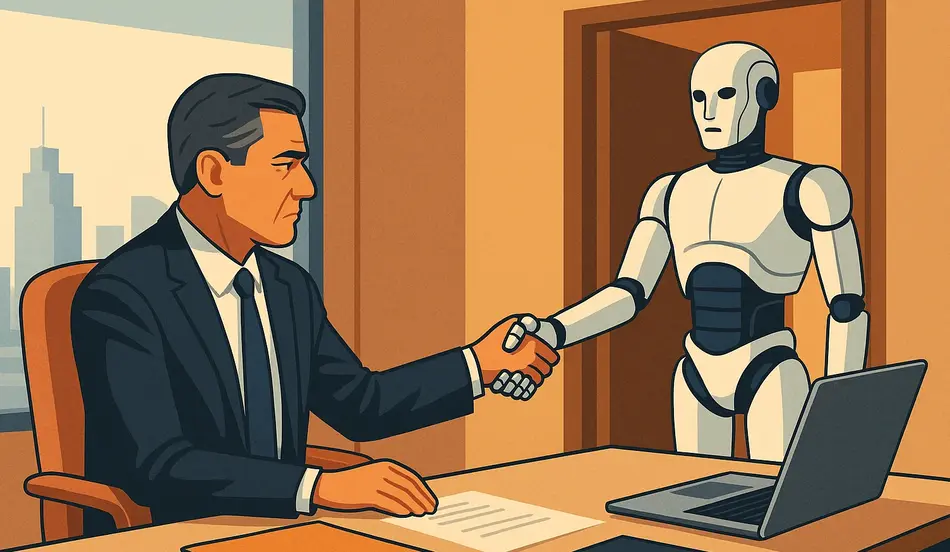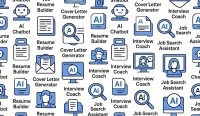Since ChatGPT’s debut, leaders have hunted for cost savings. They have a fiduciary duty to pursue efficiency, and markets reward visible reductions in operating expense. “AI can do knowledge work” turned from thought experiment into board mandate. Teams that didn’t embrace it have been cut; teams that did ran into two surprises:
- Work is messier than the dashboards suggested. Edge cases and interdependencies outnumber glossy case studies.
- AI is pricier than the pitch decks implied. Compute, integration, governance, data cleanup, security, and people to wrangle it all add up fast.
That hasn’t stopped adoption. Many employees aren’t afraid AI can do their job—they’re afraid a manager believes it can. We are now in the “find out” phase: some firms are walking back hasty automation; others are doubling down.
The Twist: Thinking Jobs Are Most Exposed
The highest-cost, highest-leverage labor in a company is senior leadership and its outsourced twin: management consulting. For decades, the consulting pyramid pushed amazing margins—armies of junior analysts assembled data and slides, senior partners sold and presented. Today’s foundation is narrowing. Why?
- Modern LLMs excel at digesting vast internal and external data, patterning it into plausible narratives and options.
- Presentation layers (decks, memos, dashboards) can be auto‑generated to a polished baseline.
- A partner still sets direction and vets implications, but less brute-force junior work is required.
Harvard Business Review has described a shift from a “pyramid” to an “obelisk”: fewer juniors at the base, a thicker midsection of experienced operators using AI, and rainmakers at the top.
Early Stumbles: When AI Goes From Copilot To Ghostwriter
Data security is non‑negotiable. Yet lapses keep appearing: sensitive uploads to public models, hallucinated citations, and insufficient human verification. One notorious example: Deloitte delivered a government report that included fabricated sources and case law, then touted a multibillion‑dollar AI investment. The misstep wasn’t using AI—it was skipping fact‑checking. The lesson: automation must raise the floor, not lower the bar.
Early Stumbles: When AI Goes From Copilot To Ghostwriter
Automation isn’t the problem — complacency is. When AI replaces human oversight, trust erodes. Data leaks, hallucinated sources, and unverified outputs damage credibility faster than they save time. AI should elevate standards, not excuse shortcuts. In the new landscape, accountability and validation are competitive advantages.
Post Jobs & Hire Responsible AI Talent →Why Clients Might Insource The “Brains”
If most of a consulting engagement is data ingestion, synthesis, and templated recommendations, internal teams armed with enterprise‑safe LLMs can produce a decent first draft. Boards often hire firms to rubber‑stamp what they already want to do. Soon, “AI‑backed” may carry the same political cover as “McKinsey‑approved.” If both are shorthand for plausible external validation, price pressure follows.
What The Research Actually Shows
Two empirical threads matter:
1) Augmentation beats replacement. MIT and others find most bespoke “full replacement” pilots fail. The ROI shows up in targeted tools that remove drudgery, expand analytical bandwidth, and speed iteration.
2) Off‑the‑shelf LLMs can outperform humans on management simulations—within bounds. In a Cambridge/HBR study, an LLM beat executives and MBA students on market share, profit, and cap‑weighted outcomes in an auto‑industry simulation. But it fared worse at the other CEO metric: not getting fired. It optimized normal‑times performance and struggled with black swans (COVID‑like shocks), where judgment, context, and risk framing matter.
Translation: AI is an excellent autopilot under normal conditions, scanning more inputs than any human. Humans should still take the yoke in turbulence.
Why Executives Won’t Be “Replaced” (Yet)—But Will Be Redesigned
There are hard constraints. Public companies need named accountable humans (principal executive, principal financial, principal accounting officers). The SEC can’t subpoena an LLM. Boards need a face to fire.
What will change is the shape of leadership:
- Flatter orgs, fewer layers. A smaller cadre of executives will span wider scopes, using AI agents to triage decisions, pre‑brief tradeoffs, and monitor risk.
- Decision bandwidth shifts. Routine approvals, forecasting, and resource planning move to human‑in‑the‑loop agents; humans focus on shocks, narratives, and stakeholder alignment.
- Consulting spend concentrates. Fewer “from‑scratch” studies; more validation, scenario stress‑tests, and change execution.
This is already happening in tech functions, per Harvard Business School research on 50,000+ participants: leaders use AI to expand reach, compress cycles, and cover more ground with fewer managers.
Three Risks Leaders Are Underestimating
1) Governance debt. Shadow prompts, data leakage, and model drift create silent risk. Without audit trails, approvals, and red‑team habits, one hallucination can become a PR or legal crisis.
2) Workload illusions. “Flat” structures devolve into one leader doing three jobs with a ChatGPT subscription. Burnout and brittle decisions follow.
3) Career‑ladder erosion. If middle‑management rungs vanish, companies starve their future executive pipeline. Fewer apprenticeships today means weaker leadership pools tomorrow.
The Executive Job, Rewritten
What stays human:
- Setting non‑negotiables and values under uncertainty.
- Handling ambiguity, paradoxes, and tradeoffs with incomplete data.
- Storytelling that moves investors, regulators, employees, and customers.
- Owning black‑swan decisions and the consequences.
What shifts to AI‑accelerated workflows:
- Synthesis: turning documents, metrics, and transcripts into decision briefs.
- Options generation with explicit pros/cons, sensitivities, and guardrails.
- Continuous scanning: competitive moves, regulatory changes, counterparty risk.
- Scenario modeling: “what‑ifs” and playbooks pre‑baked for shocks.
The leaders who thrive won’t be the loudest futurists; they’ll be the best integrators—those who pair moral clarity and situational judgment with machine‑scale perception.
Why Top Jobs Still Feel “Safe” (For Now)
Executives decide who gets augmented and who goes. Unsurprisingly, many predict disruption will spare their tier. In an IBM/Oxford survey of 3,000 C‑suite leaders, 77% expected generative AI to reshape entry‑level roles soon, but only 22% said the same for executive roles—even as most foresaw AI transforming finance, compliance, and procurement (often senior domains).
That inconsistency reveals bias, not strategy. If AI reshapes the firm’s brains, it reshapes its brain trust.
A Playbook For Leaders (And Aspiring Ones)
1) Design the “autopilot” before the “autonomous plane.” Map decisions by frequency, reversibility, and blast radius. Automate review/approval flows for low‑risk, high‑volume items; reserve human deliberation for one‑way doors and crises.
2) Make judgment legible. Require decision memos with assumptions, alternatives, and confidence levels—whether drafted by a human or an agent. You can’t manage what you can’t audit.
3) Build shock muscle. Pre‑mortems, red teams, and scenario libraries make humans faster than models when the unexpected hits—and give agents templates for triage.
4) Rebuild the ladder. Keep developmental manager roles. Pair each with AI tools that teach leverage, not shortcuts. Your future executive bench depends on it.
5) Demand secure, private, documented AI. Enterprise‑safe stacks, data classification, retrieval‑augmented generation (RAG), masked PII, and full logs. Treat prompts like code.
6) Hold the line on truth. Mandate human fact‑checks for external outputs. Hallucination is a process failure, not a feature.
Key Takeaway
AI won’t replace executives—but executives who use AI will replace those who don’t. The corner office becomes a control room: humans set direction and own the shocks; AI expands perception, speeds synthesis, and widens decision bandwidth.
FAQs
Will consulting die?
No, but the mix will shift. Less brute‑force analysis; more validation, change leadership, and complex, cross‑functional execution.
Can an AI be a CEO?
Public companies need named human officers for accountability. Practically, AI will run “autopilot” functions while humans own crises and stakeholders.
Where to start?
Pilot a human‑in‑the‑loop decision flow (e.g., forecasting, approvals). Add governance (logging, reviews), red‑team it, then scale. Tie wins to cost, speed, risk reduction—not vague innovation narratives.




